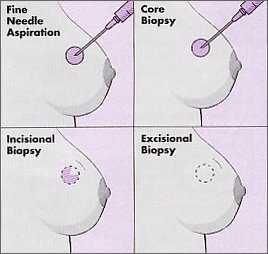A Woman's Guide to Breast Cancer Diagnosis and Treatment
BREAST BIOPSY
When you discover a lump or other changes in your breast, it is important to find out what it is. It is normal to be alarmed. But you have reasons to be reassured:
- Most women, sometime in their lives, develop lumps in their breasts.
- Most lumps are NOT breast cancer. In fact, 8 out of 10 lumps are harmless.
- To be sure that a lump or other change is not breast cancer, you need to have some or all of the lump removed (a biopsy). A diagnosis can then be made by a pathologist, a doctor who looks at the cells under a microscope, to find out if the tissue is normal or cancerous.
A. When Your Lump Can Be Felt
If your lump can be felt, you will most likely have one of the following types of biopsies.
- Fine Needle Aspiration (FNA)
A thin needle is placed into the lump. If fluid comes out, and the lump disappears, it means that the lump is a cyst and is usually not cancer.
- Advantage: You can avoid scar and surgery. If cancer is found, you can start to plan your treatment.
- Disadvantage: If the needle removes only normal cells, and the lump does not go away, then you may need more tests to make sure that the lump is not cancer.
- Core Biopsy
A larger needle is used to remove a small piece of tissue from the lump.
- Advantage: Your scar will barely be noticeable. Even if the lump is cancer, you will have avoided the stress of one surgery.
- Disadvantage: If this biopsy finds cancer, you will need more surgery to remove the part of the cancer that is still in your breast. If this biopsy does not find cancer, you may still need a surgical biopsy to make sure that the lump that is still in you breast does not contain any cancer cells.
- Surgical Biopsies
An incisional biopsy removes only a portion of the lump. An excisional biopsy removes the entire lump. You will have a scar on your breast, which will heal with time. There may be some change in the shape or size of your breast.

ANESTHESIA
If the lump is small and near the skin's surface, you will likely be given local anesthesia. Medication is injected into the site. You will be awake, but you should not feel pain. Medication also may be injected into a vein in your arm as an extra way to reduce pain and help you relax.
If you are given general anesthesia, you will be given medication that will place you in a deep sleep. You will not feel pain during surgery. These medications are most often inhaled as a gas. They may be used when the tumor is large, located deep in the breast, or when the woman does not want to awake. |
|
B. When Your Lump Can Be Seen But Not Felt
Sometimes you can have an area of concern that cannot be felt in the breast but shows up on pictures of the inside of the breast. These pictures are taken by either mammography (a type of x ray) or ultrasound, a process that shows harmless soundwaves as they travel through a breast. In these cases you may have:
Needle Localization Biopsy
Using a mammogram or an ultrasound as guide, a doctor places a needle or fine wire into the suspicious area. The area is then removed with a surgical biopsy. A second picture of the biopsy area may be taken later to make sure that the area of concern was entirely removed.
Questions to Ask Your Doctor
Do you think I need to have a biopsy? If not, why?
What type of biopsy do you recommend? Why?
How soon will I know the results?
What will the scar look like after the biopsy and after it heals?
Do you suggest local or general anesthesia? What are the advantages of each?
|
|
MAKING A DECISION
Doctors used to believe that it was best to biopsy a woman's lump and remove her breast in the same operation if cancer was found. A woman went into surgery for a biopsy not knowing whether she would wake up with her breast. This rarely happens today (Editor's note: in the U.S. Setting).
Studies show that it is safe to start treatment within several weeks after your biopsy. This two-step procedure gives you time to:
- Read more and think through the information.
- Get a second opinion.
- Talk to other women who have had breast cancer.
- Have a complete study of your breast tissue, and, if needed, of other parts of your body.
- Prepare yourself and loved ones for your treatment.
|

